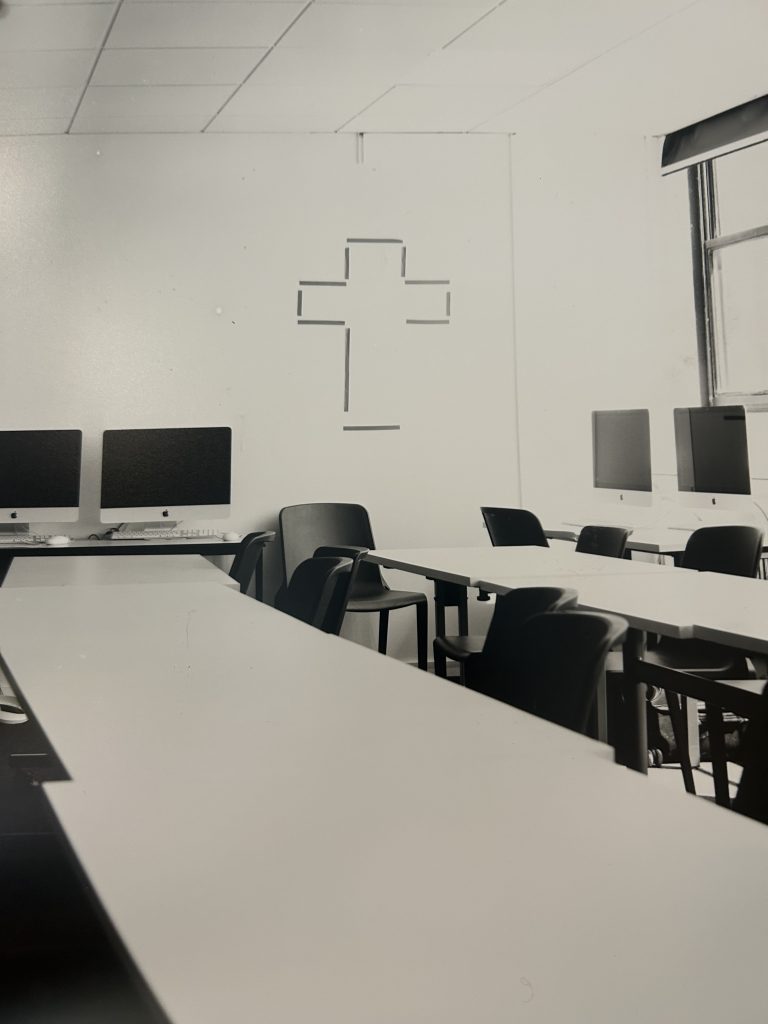Faith, Religion, and Belief
On the 11th floor of the tower block, there is a Christian cross made of tape on one of the walls. It has sat there, mostly ignored by students and staff, for the past year. For a while, a small piece of tape attached to it read, in neat capitals: ETERNAL YOUTH. This fragile, forgotten marker is an allegory for the way religion traditionally operates in HE classrooms.
Haifa Jawaad’s short piece on the LSE website presents some of the challenges faced by both people of faith, but also the barriers presented by institutions. At LCC there is a prayer room, which is often used by muslim students to pray. However, at a recent degree show this was closed. Which meant that both muslim students and visitors did not have a private space to complete their evening Maghrib prayers. In this instance I was able to let some friends into the lecture theatre. As is often the case at UAL a workaround is required to allow people to exist within the architecture of the building.
An important statistic offers further nuance. According to 2021 Census data for England and Wales, 49% of Muslim women are under the age of 25. This means that a significant portion of those impacted by gendered Islamophobia are young people, many still navigating education, employment, and public life. In addition, half of all Muslim full-time students in England and Wales are women. It’s perhaps also important to consider the ongoing entanglement between education and religion in the UK. One-third of state-funded secondary schools have a religious designation. While higher education is almost always secular, many students will arrive from religious schooling systems and bring complex identities shaped by faith, culture, and community.
These statistics can be interpreted in many ways. But at a practical level, they suggest that in a BA Photography first-year cohort at a place like London College of Communication, we can reasonably expect a sizeable proportion of religiously diverse students, many of whom have come through some form of religious education. This raises questions not only of inclusion, but also of visibility, voice, and belonging.
In the video supplied for this blog post, philosopher Kwame Anthony Appiah offers the provocation that “there is no such thing as religion,” arguing that the category itself is constructed and therefore cannot be universally praised or blamed. This can be a useful way to think critically about the abstraction of religion. But if we consider powerful institutions such as the Church, or examine the many ongoing conflicts waged in the name of religion, Appiah’s provocation might feel too neat or even evasive. It reminds us that religion cannot be separated from power structures, just as it cannot be separated from personal or collective identity.
To ignore religion in the classroom is not to neutralise it. It is to risk invisibilising it entirely. That taped-up cross on the wall may not say much, but it speaks to how faith, silence, memory, and presence co-exist in educational spaces.
Bibliography
Appiah, K.A. (2014) Is religion good or bad? (This is a trick question). TEDSalon NY. [Online video]. Available at: https://www.youtube.com/watch?v=X2et2KO8gcY (Accessed: 3 Jul. 2025).
Trinity University (2016) Challenging Race, Religion, and Stereotypes in the Classroom. [Online video]. Available at: https://www.youtube.com/watch?v=0CAOKTo_DOk (Accessed: 3 Jul. 2025).
Jawad, H. (2022) Islam, Women and Sport: The Case of Visible Muslim Women. LSE Religion & Global Society Blog, 14 Sep. [Online]. Available at: https://blogs.lse.ac.uk/religionglobalsociety/2022/09/islam-women-and-sport-the-case-of-visible-muslim-women/ (Accessed: 3 Jul. 2025) facebook.com+5blogs.lse.ac.uk+5learningandteaching.myblog.arts.ac.uk+5.
Appiah, K.A. (2018) The Lies That Bind: Rethinking Identity. London: Profile Books.
Muslim Council of Britain (MCB) (2022) Written evidence submitted by the Muslim Council of Britain (GIS0035). [Online] UK Parliament. Available at: https://committees.parliament.uk/writtenevidence/40410/html/ (Accessed: 3 Jul. 2025).Office for National Statistics (ONS) (2022) Religion, England and Wales: Census 2021. [Online] Available at: https://www.ons.gov.uk/peoplepopulationandcommunity/culturalidentity/religion/bulletins/religionenglandandwales/census2021 (Accessed: 3 Jul. 2025).
